chapter 22.1; evolution from main sequence to red giants & 22.2 star clusters & 22.3 &22.4 further evolution
1/14
There's no tags or description
Looks like no tags are added yet.
Name | Mastery | Learn | Test | Matching | Spaced |
|---|
No study sessions yet.
15 Terms
zero-age main sequence
left-hand edge of the main sequence band in the H-R diagram
zero-age: stars stopped contracting, thus becomes main-sequence, and begins to fuse hydrogen in its core
continuous line in the H-R diagram that shows where stars of different masses but similar chemical composition can be found when they begin to fuse hydrogen
when a star’s luminosity and temperature change, the point that represents the star on the H-R diagram moves away from the zero-age main sequence
lifetimes on the main sequence
how many years a star remains in the main sequence band depends on its mass
lifetime in a particular stage depends on how much nuclear field it has and how quickly it uses up that fuel
more massive stars use up their fuel more quickly than stars of low mass (rate of fusion depends strongly on the star’s core temperature, core temperature is determined by the mass of the star)
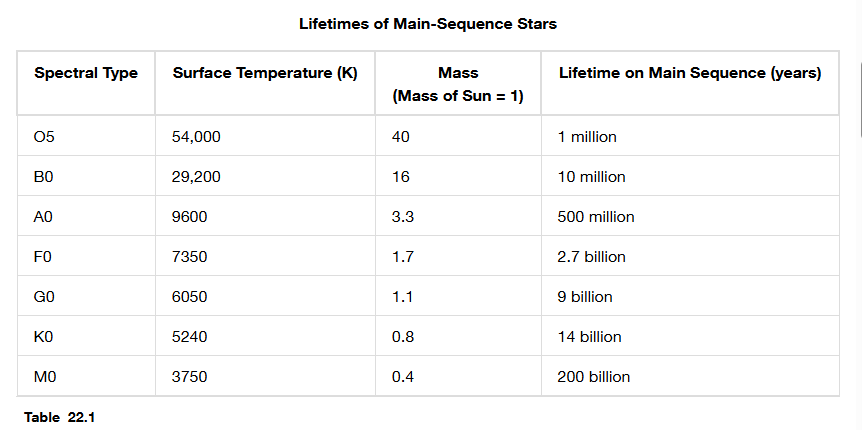
main-sequence to red giant
all hydrogen eventually runs out in a star’s core
core then contains only helium and some heavier elements
energy can no longer be generated by hydrogen fusion in the stellar core, and the fusion of helium requires much higher temperatures
no nuclear energy source to supply heat to core
thus core contracts; stars energy is partially supplied by gravitational energy (as the star’s core shrinks, the energy of the inward-falling material is converted to heat
the core becomes hot enough for an outer layer of hydrogen to undergo hydrogen fusion once again
this energy leaves this hydrogen burning shell and begins to heat up layers of the star farther out, causing them to expand
meanwhile, helium core contracts, more heat around it

increase in luminosity occurs
with new energy pouring outwards, the outer layers of the star begin to expand, and the star eventually grows and grows until it reaches enormous proportions
expansion of star’s outer layers cases the temperature at the surface to decrease (colour becomes redder)
massive stars become red super giants
lower-mass stars like the Sun become red giants
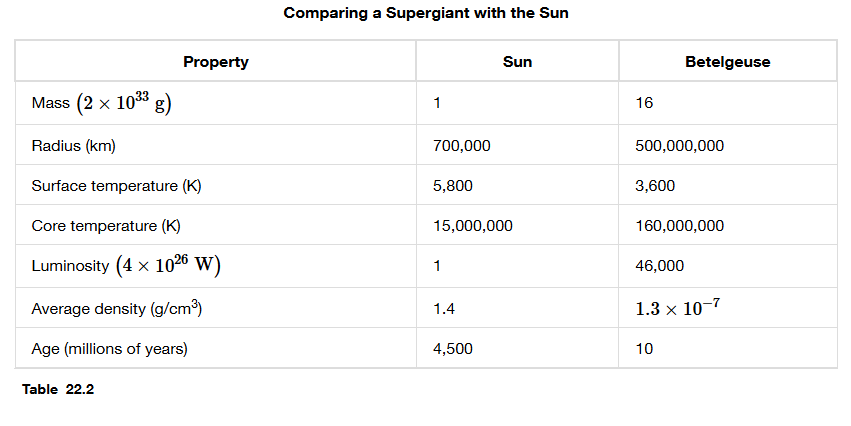

characteristics of star clusters
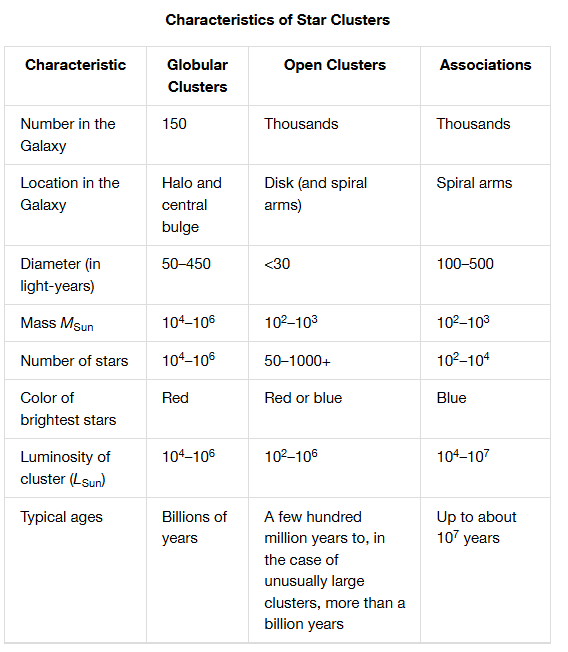
globular clusters
nearly symmetrical round systems, of hundreds of thousands of stars
most mass in Milky Way: Omega Centauri (16,000ly away, several million stars within it)
the brightest stars in this cluster, which are red giants that have already completed the main-sequence phase of their evolution, are red-orange in color, surface temperature of 4000K
within dense central regions, the stars would be roughly a million times closer together than in our own neighborhood
150 known in the Milky Way
most are in a spherical halo surrounding the flat disk formed by the majority of our Galaxy’s stars
all are very far from Sun, some at distances of 60,000ly or more away from main disk
diameters of globular star clusters: 50ly to more than 450ly
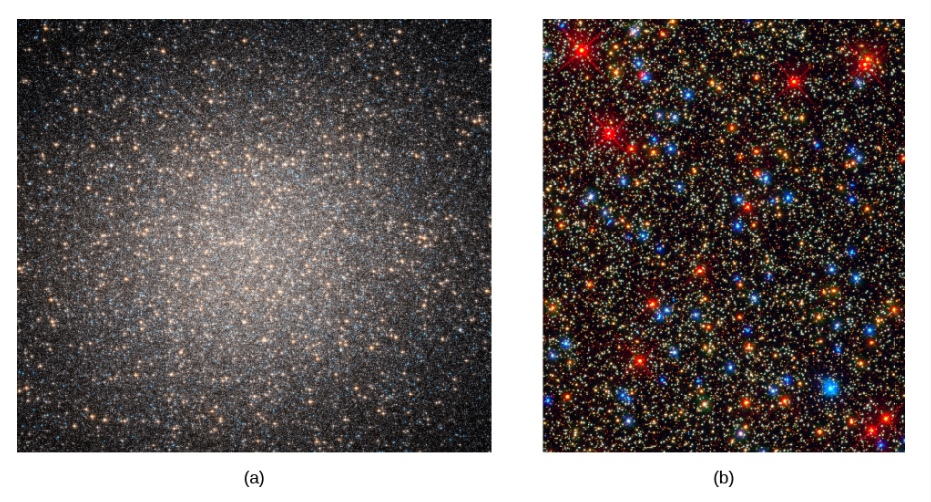
open clusters
found in disk of Milky Way
range of ages
smaller than globular clusters (diameters less than 30ly)
stars appear well separated
thousands within Milky Way
can only see a fraction, interstellar dust dims the others that are more further away
remains as a cluster for only a few million years
stellar associations
association: group of extremely young stars, typically containing 5-50 hot, bright O and B tars scattered over a region of space some 100-500 ly in diameter
e.g., most stars in Orion form stellar associations
found in regions rich in the gas and dust required to form new stars
main-sequence turnoff
the location in the H-R diagram where the stars have begun to leave the main sequence
triple-alpha process
once the core of a red giant reaches 100 million K (occurs due to the the core contracting), three helium atoms can begin to fuse to form a single carbon nucleus
helium flash
when the triple-alpha process begins in low-mass (0.8-2.0 solar masses) stars, calculations show that the entire core is ignited in a quick burst of fusion
As soon as the temperature at the center of the star becomes high enough to start the triple-alpha process, the extra energy released is transmitted quickly through the entire helium core, producing very rapid heating. The heating speeds up the nuclear reactions, which provide more heating, and which accelerates the nuclear reactions even more. We have runaway generation of energy, which reignites the entire helium core in a flash.
by the time a star has reached a helium flash, it has already lost 25% of its mass
what happens after a helium flash?
star readjusts to the release of energy from the triple-alpha process in its core
its surface temperature increase
overall luminosity decreases
star begins to fuse helium in its core for a while
However, at a temperature of 100 million K, the inner core is converting its helium fuel to carbon (and a bit of oxygen) at a rapid rate. Thus, the new period of stability cannot last very long: it is far shorter than the main-sequence stage.
all the helium will be used up, and the star cannot generate energy via fusion
star shrinks
the star now has a multi-layered structure like an onion: a carbon-oxygen core, surrounded by a shell of helium fusion, a layer of helium, a shell of hydrogen fusion, and finally, the extended outer layers of the star
As energy flows outward from the two fusion shells, once again the outer regions of the star begin to expand. Its brief period of stability is over; the star moves back to the red-giant domain on the H–R diagram for a short time
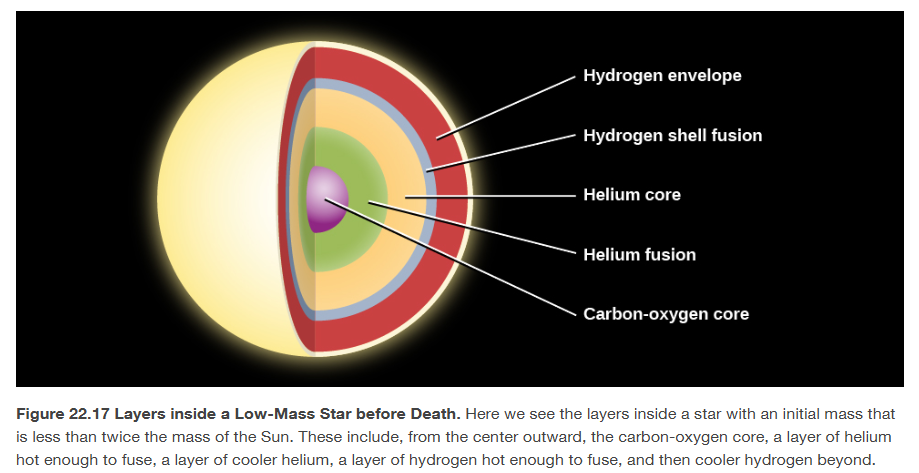
evolution of a star with sun’s mass
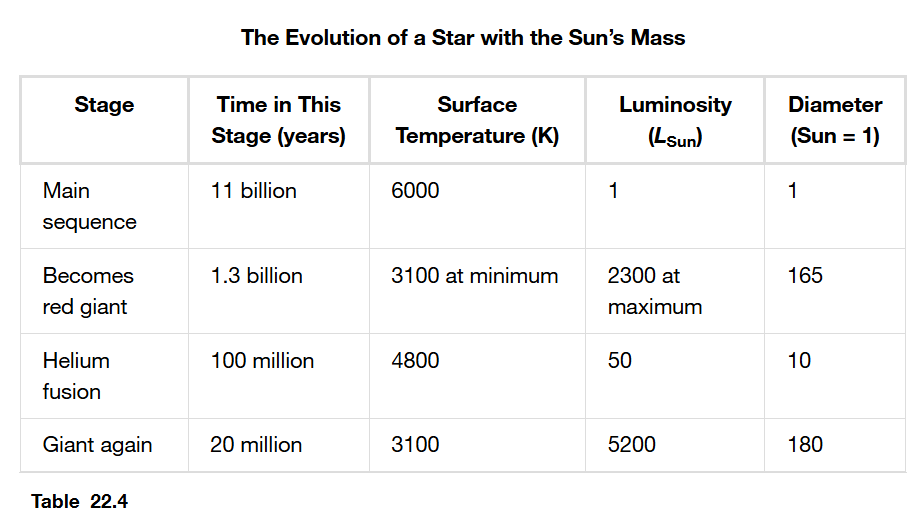
planetary nebulae
formed after stars shrink and reach surface temperatures of 100,000K
produce stellar winds and ultraviolet radiation
these winds and radiation heat shells, ionise them, and set them aglow
shells expand at speeds of 20-30km/s
diameter of about 1 ly
where are heavier elements formed?
massive stars
The outer layers of a star with a mass greater than about 8 solar masses have a weight that is enough to compress the carbon-oxygen core until it becomes hot enough to ignite fusion of carbon nuclei. Carbon can fuse into still more oxygen, and at still higher temperatures, oxygen and then neon, magnesium, and finally silicon can build even heavier elements.
Iron is, however, the endpoint of this process.
fusion of iron atoms produces products more massive than the nuclei being fused and therefore the process requires energy as opposed to releasing energy
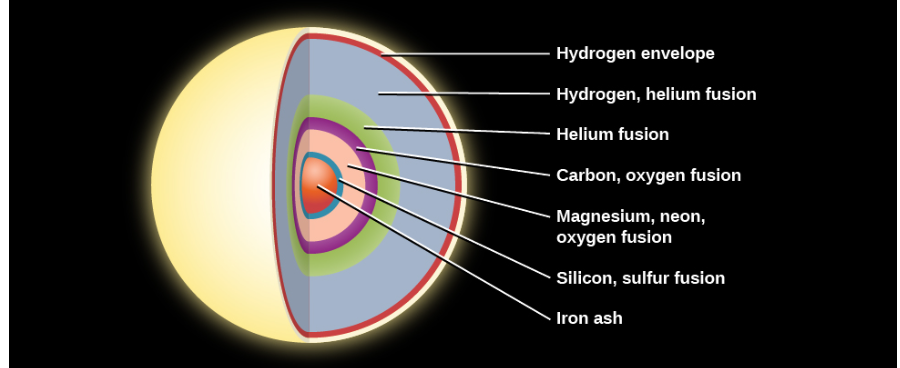
nucleosynthesis
the making new atomic nuclei